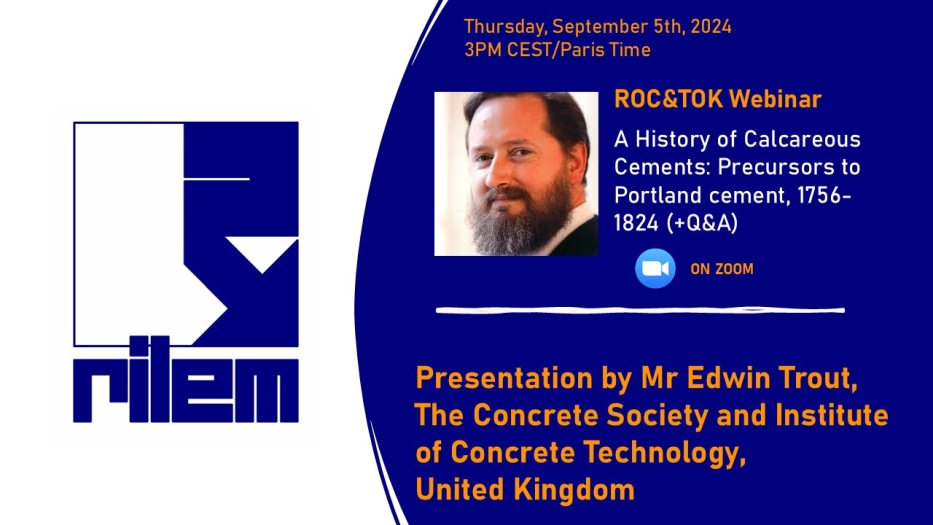Events calendar
Region : Europe

A History of Calcareous Cements: Precursors to Portland cement, 1756-1824
We are pleased to announce that the next ROC&TOK webinar will take place on September 5th, 2024 at 3PM CEST/Paris Time and will be one hour long (30-minute presentation + 30-minute interaction). The registration for this webinar is free.
Speaker: Mr. Edwin Trout, The Concrete Society and Institute of Concrete Technology, United Kingdom
Hosts: Dr Prannoy Suraneni, University of Miami, United States and Prof. Karen Scrivener, EPFL, Switzerland
Title: A History of Calcareous Cements: Precursors to Portland cement, 1756-1824
The development of binders for mortar, and to a lesser extent for concrete, in post-Renaissance Europe was born of the long-established use of air-set limes, combined – under the renewed influence of classical Rome – with pozzolana (volcanic ash from Pozzuoli) to impart hydraulic properties. In northern Europe, trass, a volcanic tuff from the Rhine and distributed through the Netherlands, became a widely used alternative to Italian pozzolana during the 16th and 17th centuries.
In the expanding economies of the 18th century – particularly in France and Britain – increasing demand for building materials to service new building and civil engineering works prompted investigations into new sources of supply and the assessment of alternatives, both of pozzolana and of suitable limes. The construction of harbour works and marine structures such as lighthouses – and increasingly in the second half of the century, canals – required the use of hydraulic binders that would set under water.
Alternatives to pozzolana were found in various locations in France, Germany and Sweden, but it was the search for naturally hydraulic limes that fuelled investigations into what it was that imparted the desired properties, and defining the key constituents. Smeaton’s trials in 1756 laid the foundations of their discovery. And having established that the presence of clay in combination with lime was vital to hydraulicity, rather than high degrees of purity previously thought, other sources of naturally occurring hydraulic lime were sought. Not only hydraulic lime, but natural cements too: most notably Parker’s so-called Roman cement patented in 1796.
As the demand for naturally hydraulic binders grew, the artificial combination of constituents was explored firstly to create manufactured hydraulic lime – perfected in practice by Vicat (1818) and in theory by J.F. John (1819) – and then cement. When Parker’s patent lapsed in 1810, innovators such as Edgar Dobbs and William Lockwood entered the market and, in 1822, James Frost introduced an artificial, low-strength ‘British’ cement, adopting aspects of Vicat’s production technology. But it was in 1824, 200 years ago, that Joseph Aspdin first patented his ‘Portland’ cement, the direct progenitor of the present cement manufacturing industry.
No comment
Log in to post comment. Log in.





